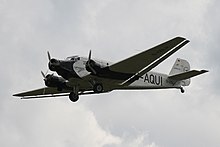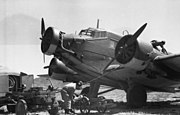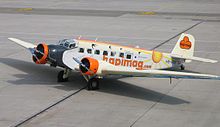Junkers Ju 52: Difference between revisions
→Military use 1935-45: hitler |
|||
| Line 52: | Line 52: | ||
The [[Seaplane|floatplane]] version, equipped with two large [[float]]s, served during the [[Norwegian Campaign]] in 1940, and later in the Mediterranean theatre. Some Ju 52 floatplanes were also used as [[Minesweeper (ship)|minesweepers]], known as ''Minensuch'' aircraft in German, fitted with a large [[degaussing]] ring under the airframe. |
The [[Seaplane|floatplane]] version, equipped with two large [[float]]s, served during the [[Norwegian Campaign]] in 1940, and later in the Mediterranean theatre. Some Ju 52 floatplanes were also used as [[Minesweeper (ship)|minesweepers]], known as ''Minensuch'' aircraft in German, fitted with a large [[degaussing]] ring under the airframe. |
||
===Hitler's personal transport=== |
|||
{{main|Die Fliegerstaffel des Fuehrers}} |
|||
Hitler used a [[Lufthansa]] Ju 52 for campaigning the 1932 German election, preferring flying to transport via train. After he became [[German Chancellor]] in 1933, [[Hans Baur]] became his personal pilot, and Hitler was provided with a personal Ju 52. Named ''Immelmann'' after the WW1 ace [[Max Immelmann]], it carried the designation D-2600. As his power and importance grew, Hilter's perosnal airforce grew to nearly 50 planes, based at [[Berlin Templehof Airport]] and made up of mainly Ju 52's, which also flew other members of his cabinet and war staff. In September 1939 at Baur's suggestion, his personal Ju 52 ''Immelman II'' was replaced by the four engined [[Focke-Wolfe FW200|Focke-Wolfe FW200 "Condor"]], although ''Immelman II'' remained his back-up plane for the rest of WW2. |
|||
===Postwar Use=== |
===Postwar Use=== |
||
Revision as of 17:32, 4 May 2009
| Junkers Ju 52 | |
|---|---|

| |
| Role | Transport aircraft |
| Manufacturer | Junkers |
| First flight | 13 October 1930 (Ju 52/1m) 7 March 1932 (Ju 52/3m) |
| Primary user | Luftwaffe |
| Produced | 1931–1945 (Germany) 1945–1947 (France) 1945–1952 (Spain) |
| Number built | 4,845 |
The Junkers Ju 52 (nicknamed Tante Ju - "Auntie Ju" - and "Iron Annie") was a transport aircraft manufactured 1932 – 1945 by Junkers. It saw both civilian and military service during the 1930s and 1940s. In a civilian role, it flew with well over a dozen air carriers including Swissair and Lufthansa as an airliner and freight hauler. In a military role, it flew with the Luftwaffe as a troop and cargo transport and briefly as a medium bomber. The Ju 52 continued in postwar service with military and civilian air fleets well into the 1980s.
Design and development
The Ju 52 was similar to the company's previous Junkers W33, although larger. In 1930, Ernst Zindel and his team designed the Ju 52 at the Junkers works at Dessau. The aircraft's unusual corrugated metal skin strengthened the whole structure.
The Ju 52 had a low cantilever wing, the mid-section of which was built into the fuselage, forming its underside. [1]It was formed around four pairs of circular cross section dural spars with a corrugated surface that provided torsional stiffening. A narrow flap ran along the whole trailing edge, well separated from it. This flap lowered the stalling speed and the arrangement became known as the "double wing.[2]

The outer sections of this operated differentially as ailerons, projecting slightly beyond the wing tips with Control Horns. The strutted horizontal stabiliser carried horn balanced elevators which again projected and showed a significant gap between them and the stabiliser, which was adjustable in-flight. All stabiliser surfaces were corrugated.
The fuselage was of rectangular section with a domed decking, all covered with corrugated light alloy. There was a port side passenger door just aft of the wings, with windows stretching forward to the pilots' cabin. The main undercarriage was fixed and divided; some aircraft had wheel fairings, others not. There was a fixed tail skid, or later tail wheel. Some aircraft were fitted with floats or skis instead of the main wheels.
In its original configuration, designated the Ju 52/1m, the Ju 52 was a single-engined aircraft, powered by either a BMW or Junkers liquid-cooled engine. However, the single-engine model was underpowered, and after seven prototypes had been completed, all subsequent Ju 52s were built with three radial engines as the Ju 52/3m (German drei motoren, meaning "three engines"). Originally powered by three Pratt & Whitney Hornet radial engines, later production models mainly received 770 hp BMW 132 engines, a licence-built refinement of the Pratt & Whitney design. Export models were also built with 600 hp Pratt & Whitney Wasp R-1340 and 775 hp Bristol Pegasus VI engines. The two wing mounted radial engines of the Ju.52/3m had full chord cowlings and were noticeably toed-out. The central engine had a half chord cowling like a Townend ring as the fuselage behind it was increasing in diameter, though some later aircraft had deeper cowlings.
Operational history

Pre-war civil use
In 1936, James A. Richardson's Canadian Airways received (Werknummer 4006) CF-ARM , the sixth ever-built Ju 52/1m. The aircraft, re-engined with a Rolls-Royce Buzzard and nicknamed the "Flying Boxcar" in Canada,[3] could lift approximately three tons and had a maximum weight of eight tons. It was used to supply mining and other operations in remote areas with equipment too big and heavy for other aircraft then in use. The Ju 52/1m was able to land on wheels, skis or floats.[1]
Before the nationalisation of the German aircraft industry in 1935, the Ju 52/3m was produced principally as a 17 seat airliner. It was principally used by Lufthansa and could fly from Berlin to Rome in eight hours. Lufthansa's fleet eventually numbered 80 and flew from Germany on routes in Europe, Asia and South America.
Military use 1935-45


The Ju 52 first saw military service in the Spanish Civil War, as both a bomber and transport aircraft. In the former role it participated in the bombing of Guernica. No more of the bomber variant were built after this war, though it was again used as a bomber during the bombing of Warsaw[4] during the Invasion of Poland of September 1939. The Luftwaffe then relied on the Ju 52 for transport roles during World War II, including paratroop drops, most notably in the Battle of Crete in May 1941. Lightly armed, and with a top speed of only 165 mph – half that of a contemporary Spitfire – the Ju 52 was very vulnerable to fighter attack and an escort was always necessary when flying in a combat zone. Many Ju 52s were shot down by anti-aircraft guns and fighters while transporting supplies, most notably during the desperate attempt to resupply the trapped German Sixth Army during the final stages of the Battle of Stalingrad in 1943.


During the final phase of the North African Campaign 24 of the Junkers were shot down in the infamous "Palm Sunday Massacre" on 18 April 1943, another 35 staggered back to Sicily and crash-landed. The transports' escort, Luftwaffe Geschwader JG 27, claimed just one enemy fighter[5].
The floatplane version, equipped with two large floats, served during the Norwegian Campaign in 1940, and later in the Mediterranean theatre. Some Ju 52 floatplanes were also used as minesweepers, known as Minensuch aircraft in German, fitted with a large degaussing ring under the airframe.
Hitler's personal transport
Hitler used a Lufthansa Ju 52 for campaigning the 1932 German election, preferring flying to transport via train. After he became German Chancellor in 1933, Hans Baur became his personal pilot, and Hitler was provided with a personal Ju 52. Named Immelmann after the WW1 ace Max Immelmann, it carried the designation D-2600. As his power and importance grew, Hilter's perosnal airforce grew to nearly 50 planes, based at Berlin Templehof Airport and made up of mainly Ju 52's, which also flew other members of his cabinet and war staff. In September 1939 at Baur's suggestion, his personal Ju 52 Immelman II was replaced by the four engined Focke-Wolfe FW200 "Condor", although Immelman II remained his back-up plane for the rest of WW2.
Postwar Use
Various Junkers Ju 52s continued in military and civilian use following World War II. In 1956, the Portuguese Air Force, who was already using the Ju 52s as a transport plane, employed the type as a paratroop drop aircraft for its newly organized elite parachute forces, later known as the Batalhão de Caçadores Páraquedistas. The paratroopers used the Ju 52 in several combat operations in Angola and other Portuguese African colonies before gradually phasing it out of service in the 1960s.[6]
The Swiss Air Force also operated the Ju 52 from 1939 to 1982 when three machines remained in operation, probably the last and longest service in any air force[7]. They are still in flying condition and together with a CASA 352 can be booked for sightseeing tours with Ju-Air [8].
During the fifties the Ju 52 was also used by the French Air Force during the Indo-China War as a bomber. The usage of these Junkers were quite limited.[9]
Some Ju 52s were converted to civilian use. For example B.E.A. operated eleven ex-RAF Ju 52/3mg8e machines from 1946–47 on intra-U.K. routes before Dakotas took over.[2] French airlines like the S.T.A. and Air France flew Toucans in the late 1940s.
A Ju-52 and a Douglas DC-3 were the last aircraft to take off from Tempelhof Airport before all operations ceased there.[10]
Other versions
Most Ju 52s were destroyed after the war, but 585 were manufactured after 1945. In France the machine had been manufactured during the war by the Junkers-controlled Amiot company, and production continued afterwards as the Amiot AAC 1 Toucan. In Spain, Construcciones Aeronáuticas SA continued production as the CASA 352 and 352L. Four CASA 352s are airworthy and in regular use today.
Variants
- Ju 52
- Single-engined transport aircraft, 7 built. First flight 3 September 1930
- Ju 52/3m
- Three-engined prototype, powered by three 410 kW (550 hp) Pratt & Whitney Hornet engines. First flight 7 March 1932
- Ju 52/3mce
- Three-engined civil transport aircraft.
- Ju 52/3mge
- Interim bomber and transport aircraft for the Luftwaffe.
- Ju 52/3mg3e
- Improved military version, powered by three 541 kW (725 hp) B.M.W. 123-A3 radial piston engines, equipped with improved radio and bomb release mechanism.
- Ju 52/3mg4e
- Military version. The tailskid was replaced by a tailwheel.
- Ju 52/3mg5e
- Military version, powered by three 619 kW (830 hp) B.M.W. 123T radial piston engines. It could be fitted with interchangeable float, ski and wheel landing gear.
- Ju 52/3mg6e
- Equipped with a simplified radio.
- Ju 52/3mg7e
- Fitted with autopilot and a large loading hatch.
- Ju 52/3mg8e
- Fitted with an extra cabin roof hatch.
- Ju 52/3mg9e
- Late production version, fitted with strengthened landing gear and glider towing gear.
- Ju 52/3mg10e
- Similar to the Ju 52/3mg9e, but it could be fitted with floats or wheels.
- Ju 52/3mg11e
- No details are known.
- Ju 52/3mg12e
- Powered by three B.M.W. 123L radial piston engines.
- Ju 52/3m12e
- Some Ju 52/3mg12s were sent to Lufthansa.
- Ju 52/3mg13e
- No details are known.
- Ju 52/3mg14e
- this was the last German production version.
- A.A.C. 1 Toucan
- Post-war French version, 415 built.[11]
- CASA 352
- Post-war Spanish version, 106 built.[11]
- CASA 352L
- Spanish version with Spanish ENMA (ex-Elizalde) Beta B-4 engines, 64 built.[11]
- C-79
- Designation assigned to a single example operated by the United States Army Air Forces.
- T2B
- Designation used by the Spanish Air Force.
Operators



 Argentina
Argentina Austria
Austria Belgium
Belgium Bolivia
Bolivia Brazil
Brazil Bulgaria
Bulgaria Canada
Canada China
China Colombia
Colombia Croatia
Croatia Czechoslovakia
Czechoslovakia Denmark
Denmark Ecuador
Ecuador Estonia
Estonia Finland
Finland France
France Germany
Germany Germany
Germany Greece
Greece Hungary
Hungary Italy
Italy Norway
Norway Peru
Peru Poland
Poland Portugal
Portugal Kingdom of Romania
Kingdom of Romania South Africa
South Africa Slovakia
Slovakia Soviet Union
Soviet Union Spanish State
Spanish State Sweden
Sweden Switzerland
Switzerland United Kingdom
United Kingdom United States
United States Uruguay
Uruguay Yugoslavia
Yugoslavia
Survivors
- Junkers Ju 52/3m (CASA 352L) is on display at the Royal Air Force Museum in Cosford. [12]
- Junkers Ju 52/3m (CASA 352L) is on display at the Steven F. Udvar-Hazy Center of the National Air & Space Museum in Chantilly, Virginia
- Junkers Ju 52 (CASA 352L) is on display at the National Museum of the United States Air Force in Dayton, Ohio
- Junkers Ju-52/3m (Nord AAC.1Touqan) is on display at Belgrade airport Aeronautical Museum
- Junkers Ju-52/3mg4e (Werksnummer:6693)is on display at "Ju52-Hangar" of Traditionsgemeinschaft Lufttransport Wunstorf e. V.(Air Transport Community of Tradition) near Wunstorf/Germany. http://www.tglw.de/ju52engl.htm
- Junkers Ju 52 (CASA 352L) (N352JU) is on display at the American Airpower Heritage Museum at Midland International Airport near Midland, Texas.
- Junkers Ju-52/3m (LN-DNL) is on display at the Norwegian National Museum of Aviaton. [2]
Apart from the last listed, these are all non-flyers; the list is not complete. As of 2008, 4 Ju 52 remain in operation, providing vintage flights from Dübendorf airport. All flying Ju 52 are listed here.
Specifications (Junkers Ju 52/3m g7e)
Data from Jane’s Fighting Aircraft of World War II[13]
General characteristics
- Crew: 3 (two pilots, radio operator)
- Capacity: 18 troops or 12 litter patients
Performance
Armament
- Guns:
- Bombs: up to 455 kg (1,000 lb) of bombs (some variants)
See also
Related development
Aircraft of comparable role, configuration, and era
Related lists
References
- Notes
- ^ Grey and Bridgman 1972
- ^ a b Jackson 1960, p. 100.
- ^ C.B. "'Bud' Johnston Library." Rolls-Royce of Canada Ltd., Montreal Quebec.
- ^ Warsaw
- ^ Weal 2003, p. 91.
- ^ Afonso and Gomes 2000, pp. 178–183.
- ^ http://swiss airforce history
- ^ Museum of Military Aviation
- ^ Duwelz, Yves. "Junkers Ju 52/3mge W Nr 5670 6309." Aviation Heritage in Belgium, October 2001. Retrieved: 4 April 2009.
- ^ Kulish, Nicholas. "Crowds Bid Fond Farewell to Airport That Saved Berlin." New York Times, 30 October 2008. Retrieved: 4 April 2009.
- ^ a b c Blewett 2007
- ^ "Junkers Ju52/3M (CASA 352L) airplane pictures- RAF Museums."
- ^ Jane 1946, pp. 170–171.
- ^ Originally measured as 725 PS
- Bibliography
- Afonso, Aniceto and Carlos de Matos Gomes. Guerra Colonial. Lisbon : Editorial Notícias, 2000. ISBN 9-72461-192-2.
- Blewett, R.Survivors (Aviation Classics). Coulsdon, UK: Gatwick Aviation Society, 2007. ISBN 978-0-9530413-4-3
- Grey, Charles Gibson and Leonard Bridgman. Jane's All the World's Aircraft 1938. London: Newton Abott, David & Charles, 1972. ISBN 0-7153-5734-4.
- Jackson, A.J.British Civil Aircraft 1919-59, vol 2. London: Putnam, 1960.
- Jane, Fred T. "The Junkers Ju 52/3m." Jane’s Fighting Aircraft of World War II . London: Studio, 1946. ISBN 1-85170-493-0.
- Swiss Air Force history
- Weal, John. Jagdgeschwader 27 'Afrika'. Oxford, UK: Osprey, 2003. ISBN 1-841765-38-4.
External links
- www.ju52-3m.ch
- www.constable.ca
- South African Historic Flight
- Deutsche Lufthansa Berlin Stiftung
- Documentary fragment depicting Ju 52 airliner service
